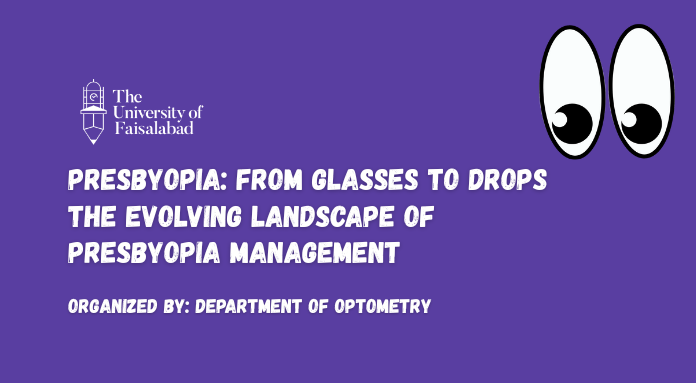Symposium on Presbyopia: From Glasses to Drops – The Evolving Landscape of Presbyopia Management
Advancing Vision Care Through Innovation
The University of Faisalabad recently hosted an insightful symposium on presbyopia, focusing on the shift from traditional glasses to modern pharmacological solutions. The event brought together experts, faculty members, and students from the field of optometry and vision sciences to discuss the latest advancements, treatment options, and research developments within presbyopia management.
Presbyopia, a naturally occurring age-related condition that affects near vision, continues to impact millions worldwide. This symposium served as a vital platform to explore how medical science is reshaping treatment approaches, making vision care more accessible, comfortable, and technology-driven.
Understanding the Evolving Treatment Options
From Conventional Glasses to Advanced Therapeutic Drops
During the symposium, specialists highlighted the limitations of conventional reading glasses and the growing role of innovative pharmaceutical eye drops that improve near vision. Presenters discussed how these drops work by altering pupil size, enhancing depth of focus, and improving visual clarity for daily tasks.
Research, Patient Outcomes, and Future Trends
The session also explored emerging research, long-term efficacy, and patient experiences with new presbyopia management tools. Attendees were introduced to clinical data, comparative studies, and projected advancements, providing a comprehensive view of how optometry and vision sciences are evolving. The symposium encouraged young professionals to embrace innovation, evidence-based practice, and continuous learning.
Connecting Innovation with Institutional Growth
The discussions at the event reflected the importance of strengthening research, medical infrastructure, and modern healthcare systems. The introduction of advanced presbyopia treatments showcases how educational institutions can play a central role in promoting scientific progress and enhancing quality care.
Industry, Innovation, and Infrastructure
Such scientific gatherings contribute directly to the development of a strong healthcare infrastructure and encourage innovation across medical fields. By promoting cutting-edge research and industry collaboration, institutions help build a future where technology and healthcare work hand in hand. These initiatives strengthen both clinical practice and national capacity for medical advancement.
Conclusion
The symposium on presbyopia successfully highlighted the transition from traditional visual aids to innovative therapeutic solutions. By fostering dialogue, research awareness, and clinical learning, the event demonstrated the University’s commitment to advancing eye care. This evolving landscape of presbyopia management reflects a promising future—one where innovation leads to improved vision and better quality of life for individuals worldwide.

